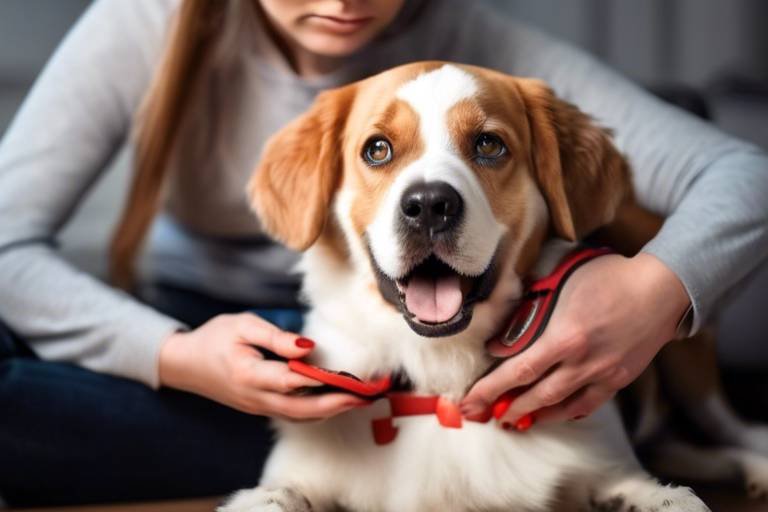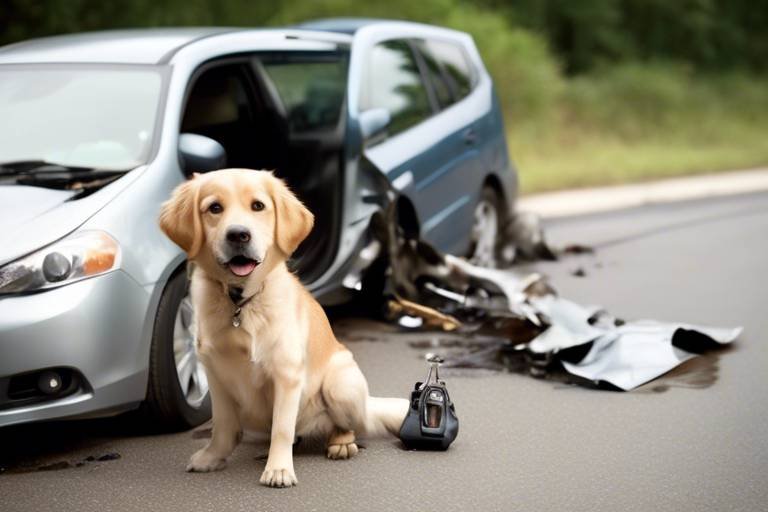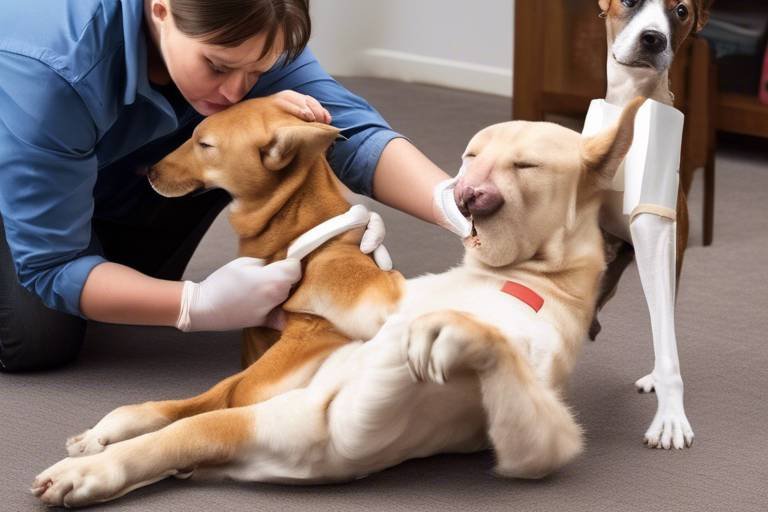How to Prepare for a Pet Emergency - A Checklist
When it comes to our furry companions, being prepared for an emergency is crucial. Just like we have emergency plans for our families, our pets deserve the same level of care and attention. Imagine the panic of a sudden storm or an unexpected injury. Wouldn't it be comforting to know that you have everything you need at your fingertips? This article provides essential guidelines and a comprehensive checklist to help pet owners prepare for emergencies involving their pets, ensuring safety and well-being during unexpected situations.
Pet emergencies can range from minor injuries to life-threatening situations. Recognizing the types of emergencies can help owners respond effectively and ensure their pets receive the necessary care promptly. For instance, a simple cut might seem minor, but if left untreated, it can lead to serious infections. On the other hand, a sudden change in your pet's behavior could indicate a more severe issue. Being aware of these possibilities can make all the difference in how quickly you react. Think of it like being a superhero for your pet—knowing when to spring into action can save the day!
An emergency kit is crucial for pet safety. It should include essential supplies such as food, water, medications, and first aid items to ensure your pet's needs are met during a crisis. Imagine being in a situation where you can't access your usual supplies; having a well-stocked kit can be a lifesaver. Consider including:
- Non-perishable food and a manual can opener
- Fresh water and collapsible bowls
- Any necessary medications
- First aid supplies, including bandages and antiseptic
- Leash, harness, and carriers for safe transport
By preparing an emergency kit, you're not just checking off a box; you're ensuring peace of mind for both you and your pet.
Having a list of emergency contacts is vital. This includes your veterinarian, local animal hospitals, and emergency pet services to ensure quick access to professional help when needed. Think about it—if your pet suddenly falls ill, the last thing you want to do is scramble to find contact numbers. Instead, keep a printed list in your emergency kit and save them on your phone. You might also want to include:
- Nearby friends or family who can help
- Local animal shelters
- Pet poison control hotline
With this list handy, you can focus on what truly matters: your pet's health and safety.
Proper identification is essential for reuniting lost pets with their owners. Microchipping and ID tags can significantly increase the chances of finding your pet during an emergency situation. Imagine the horror of losing your pet in a chaotic situation! A microchip, which is a tiny device implanted under your pet's skin, can provide a permanent ID. Coupled with a collar that has an ID tag, you create a safety net that can bring your beloved companion back home. Always ensure that your contact information is current—after all, what good is a microchip if it leads to an outdated address?
In case of a natural disaster or other emergencies, knowing evacuation routes is critical. Familiarize yourself with pet-friendly shelters and safe locations to ensure you can evacuate quickly and safely. Just like you have a fire escape plan for your home, have a similar strategy for your pet. Consider using a map to mark out routes, and practice these routes with your pet so they know what to expect. This preparation can help reduce anxiety for both you and your furry friend during a stressful situation.
Training your pet to respond to emergency situations can save lives. Basic commands and desensitization to loud noises or sudden movements can help your pet remain calm during stressful times. Think of it as teaching your pet how to be a good teammate in a crisis. Start with basic commands like “stay” or “come,” and gradually introduce them to situations that mimic emergencies, like loud noises or crowds. The more familiar they become with these scenarios, the better they will handle real emergencies.
Regular health check-ups and vaccinations are essential for preventing emergencies. Keeping track of your pet's health allows you to catch potential issues early and ensure they are always in optimal condition. Just like we visit the doctor for check-ups, our pets need that same level of care. Create a health tracking sheet that includes vaccination dates, vet visits, and any medications. This proactive approach can prevent many emergencies from arising in the first place.
Knowing basic first aid for pets can be lifesaving. Familiarizing yourself with common injuries and how to treat them can help you act quickly and effectively in emergency situations. For example, knowing how to treat a cut or manage choking can make a world of difference. Consider taking a pet first aid course to equip yourself with the necessary skills. Remember, in an emergency, every second counts!
Understanding local hazards, such as natural disasters or wildlife threats, is crucial for pet safety. Stay informed about potential risks in your area and prepare accordingly to protect your pet. Whether it’s floods, hurricanes, or even wild animal encounters, knowledge is power. Sign up for local alerts and keep an eye on weather forecasts. By being proactive, you can ensure your pet stays safe no matter what challenges arise.
Q: What should I include in my pet emergency kit?
A: Your kit should include food, water, medications, first aid supplies, a leash, and a carrier.
Q: How can I ensure my pet is properly identified?
A: Use a combination of ID tags, collars, and microchips to increase the chances of reuniting with your pet.
Q: What basic first aid skills should I learn for my pet?
A: Familiarize yourself with how to treat cuts, manage choking, and perform CPR on pets.
Q: How can I help my pet cope with emergencies?
A: Training them with basic commands and exposing them to controlled stressful situations can help.

Understanding Pet Emergencies
When it comes to our furry companions, understanding what constitutes a pet emergency is crucial. Emergencies can vary significantly, from minor scrapes and cuts to severe health crises that require immediate veterinary attention. Recognizing these situations can mean the difference between life and death for your beloved pet. So, what exactly should you be on the lookout for? Let's dive into the world of pet emergencies.
First off, it's important to note that emergencies can arise from a variety of sources. They might stem from accidents, sudden illnesses, or even natural disasters. For instance, a pet may suffer an injury from a fall or a car accident, which can lead to bleeding or broken bones. On the other hand, sudden health issues like seizures or difficulty breathing can emerge without any prior warning. This unpredictability is what makes it essential for pet owners to stay alert and informed.
Some common types of emergencies include:
- Trauma: This includes any physical injury, such as fractures, cuts, or internal injuries caused by accidents.
- Poisoning: Ingesting toxic substances, whether it’s human food, plants, or chemicals, can lead to severe health issues.
- Respiratory Distress: Difficulty breathing can indicate serious health problems like an allergic reaction or heart issues.
- Seizures: These can be alarming and may indicate underlying health conditions that need immediate attention.
Understanding the signs of distress in your pet is equally important. Pets can’t communicate like humans do, so you’ll need to be observant. Look for symptoms such as:
- Excessive barking or meowing
- Unusual lethargy or lack of appetite
- Vomiting or diarrhea
- Visible pain or discomfort
In addition to recognizing emergencies, it’s also essential to have a plan in place for various situations. This includes knowing the location of the nearest veterinary clinic and having a list of emergency contacts readily available. Being prepared can help you react swiftly and calmly when your pet needs help the most.
Remember, the best way to handle a pet emergency is to stay calm and collected. Your pet can sense your anxiety, and your reassurance can make a world of difference. By being proactive and informed, you can ensure the safety and well-being of your furry friend when the unexpected occurs.
Q: What should I do if my pet is injured?
A: Remain calm, assess the injury, and if it's serious, take your pet to the vet immediately. If it's a minor injury, you can clean the wound and apply a bandage, but monitor your pet closely.
Q: How can I tell if my pet has ingested something toxic?
A: Symptoms can vary but may include vomiting, diarrhea, drooling, or seizures. If you suspect poisoning, contact your vet or an emergency animal clinic right away.
Q: What are the signs of a pet in distress?
A: Look for excessive vocalization, changes in behavior, hiding, or signs of pain like whining or limping.
Q: Should I have a pet first aid kit?
A: Absolutely! A pet first aid kit can be invaluable during emergencies and should include items like bandages, antiseptic wipes, and a muzzle.

Creating an Emergency Kit
When it comes to our furry friends, being prepared for an emergency is not just a good idea; it's a necessity. Imagine the panic of a sudden crisis where your pet's safety is on the line. Having an emergency kit ready can make all the difference, ensuring that you and your pet are ready to face any unexpected situation. An emergency kit is essentially a lifeline that provides your pet with the essentials they need during a crisis. But what exactly should go into this kit? Let's break it down.
Your emergency kit should be tailored to your pet's specific needs, but there are some universal items that every pet owner should consider. First and foremost, you’ll want to pack enough food and water to last at least three days. This means choosing high-quality, non-perishable food that your pet is already accustomed to. Additionally, don’t forget to include a portable water bowl; hydration is key!
Next, think about medications. If your pet requires any prescription drugs, make sure to include at least a week's supply in your kit. This can be a lifesaver if you find yourself unable to access your regular vet during an emergency. Alongside medications, a first aid kit tailored for pets is essential. This should contain items such as:
- Gauze and bandages
- Antiseptic wipes
- Scissors
- Adhesive tape
- Thermometer
It's also wise to include a copy of your pet's medical records, vaccination history, and any important documents in a waterproof bag. This way, you have all the necessary information at your fingertips should you need to visit an emergency vet.
Don’t forget about comfort items! Just like humans, pets can get anxious during stressful times. Including a favorite blanket or toy can provide a sense of security for your pet when everything around them is chaotic. Furthermore, if your pet has a specific diet or allergies, make sure to tailor the food selections accordingly.
Lastly, consider the importance of identification. Ensure your pet has a collar with an ID tag that includes your contact information. Additionally, microchipping your pet can significantly increase the chances of a happy reunion if they get lost during an emergency. This small chip can be a lifesaver!
In summary, an emergency kit is not just a box of supplies; it's a carefully curated collection of items that can help your pet navigate through tough times. By preparing in advance, you can ensure that your furry family member stays safe, healthy, and as comfortable as possible, even when the unexpected strikes.

Identifying Emergency Contacts
When it comes to our beloved pets, being prepared for emergencies is not just a good idea—it's absolutely essential. Imagine this: your furry friend gets into a sticky situation, and the clock is ticking. The last thing you want is to scramble through your phone, trying to remember who to call. That’s why having a well-organized list of emergency contacts is crucial. This list should not only include your regular veterinarian but also local animal hospitals and emergency pet services. Think of it as your pet's lifeline during a crisis.
Start by jotting down your primary veterinarian's contact information. This is the person who knows your pet best and can provide immediate advice or care. But don’t stop there! It's wise to have the numbers of nearby animal hospitals, especially those that operate 24/7. You never know when an emergency might strike, and having these contacts readily available can save precious time. Additionally, consider including emergency pet service providers, such as mobile vet services or pet ambulance companies, if they exist in your area.
To make things even easier, you might want to create a simple table that organizes this information neatly. Here’s a quick example:
| Contact Type | Name | Phone Number | Address |
|---|---|---|---|
| Primary Veterinarian | Dr. Smith | (123) 456-7890 | 123 Pet Lane, Pet City |
| Emergency Animal Hospital | Animal Care 24/7 | (987) 654-3210 | 456 Vet Ave, Pet City |
| Mobile Vet Service | Vet on Wheels | (555) 555-5555 | 789 Animal Blvd, Pet City |
Once you have your contacts set, make sure to keep this information in a place where you can easily access it—perhaps on your refrigerator, in your wallet, or even saved in your phone under a special contact group labeled “Pet Emergency.” This way, when panic strikes, you won’t have to think twice about where to find the help you need.
Lastly, don’t forget to share this information with anyone who might be responsible for your pet. Whether it's a family member, a friend, or a pet sitter, ensuring they have access to these contacts can make a world of difference in an emergency. Remember, a little preparation goes a long way in keeping your furry companions safe and sound!
- What should I do if my pet gets injured? Contact your veterinarian immediately or take your pet to the nearest emergency animal hospital.
- How often should I update my emergency contact list? It's a good idea to review and update your list at least once a year or whenever you change vets or move.
- Can I rely on my phone for emergency contacts? While your phone is handy, it's best to have a printed copy in case of battery failure or connectivity issues.

Pet Identification and Microchipping
When it comes to ensuring the safety of your furry friends, pet identification is a crucial step that every pet owner should prioritize. Imagine this: your beloved dog slips out the door during a storm, and suddenly, panic sets in. Without proper identification, the chances of reuniting with your pet diminish significantly. This is where microchipping comes into play. Microchips are tiny devices, about the size of a grain of rice, implanted under your pet's skin. They contain a unique identification number that links your pet to your contact information in a national database. If your pet goes missing, shelters and veterinary clinics can easily scan the chip and contact you, making it a lifesaver in emergency situations.
But microchipping alone isn’t enough. It’s also vital to ensure that your pet wears a collar with an ID tag that has your phone number and address. This provides immediate identification if your pet is found by someone who may not have access to a scanning device. Think of it as a double safety net—one that works in tandem with microchipping to increase the chances of a happy reunion.
Here’s a quick comparison of the two methods:
| Feature | Microchipping | ID Tags |
|---|---|---|
| Visibility | Not visible | Visible |
| Cost | One-time fee | Varies (usually inexpensive) |
| Information Update | Requires updating in the database | Can be updated easily |
| Risk of Loss | Very low | Can be lost or damaged |
It's essential to keep your contact information up to date in the microchip registry. If you move or change your phone number, take a few minutes to update the information. A microchip is only as good as the data it carries, so don’t overlook this critical step!
In addition to microchipping and ID tags, consider getting your pet a personalized collar with your pet’s name and your contact information embroidered on it. This can be particularly helpful if your pet escapes and is found by someone who might not think to check for a microchip or ID tag right away.
In conclusion, investing time and resources into proper pet identification is not just a good idea; it’s a necessity. The peace of mind that comes from knowing your pet can be identified and returned to you is invaluable. After all, our pets are family, and we would do anything to keep them safe. So, take the proactive steps today to ensure your pet is well-identified and ready for any unexpected situation!
- How much does microchipping cost? Microchipping typically costs between $25 to $50, which is a one-time fee.
- Is microchipping painful for my pet? The procedure is similar to a routine vaccination and is generally quick and causes minimal discomfort.
- Can I track my pet with a microchip? No, microchips do not have GPS capabilities. They only store identification information.
- How often should I check my pet's ID tag? Regularly check the tag for wear and tear, and ensure that the contact information is current.

Planning Evacuation Routes
When it comes to ensuring the safety of your furry friends during an emergency, is a crucial step that many pet owners overlook. Imagine being caught in a sudden disaster, like a wildfire or a flood, and not knowing where to go. It’s not just about grabbing your pet and running; it’s about having a clear plan in place that can save precious time and, ultimately, lives. So, how do you prepare for such situations? Let's dive into the essentials!
First off, it's essential to familiarize yourself with the local geography and potential hazards in your area. Are there rivers that might flood? Are you near a forest that could catch fire? Understanding these factors can help you identify the safest routes and shelters for your pet. Create a map of evacuation routes that you and your family can easily access. Marking out both primary and secondary routes can provide you with options if one path becomes impassable.
Next, consider the availability of pet-friendly shelters. Not all emergency shelters accept pets, so it’s vital to research and compile a list of places that do. This list should include contact information and any specific requirements they might have, such as proof of vaccinations. You can create a simple table to keep this information organized:
| Shelter Name | Location | Contact Number | Requirements |
|---|---|---|---|
| Safe Haven Pet Shelter | 123 Pet St, Cityville | (555) 123-4567 | Vaccination proof |
| City Emergency Center | 456 Rescue Rd, Cityville | (555) 987-6543 | None |
Additionally, it's wise to practice your evacuation plan with your pet. Just like humans, pets can become anxious or confused in stressful situations. By taking your pet on practice runs, you can help them become accustomed to the process and reduce their stress during an actual emergency. Use treats and positive reinforcement to make the experience enjoyable for them.
Lastly, always keep your pet's essentials ready to go. Have a dedicated pet emergency bag that includes food, water, medications, and any comfort items like their favorite blanket or toy. This way, you can grab everything you need in one swift motion when time is of the essence.
In conclusion, planning evacuation routes for your pet is not just a precaution; it’s a responsibility that every pet owner should take seriously. By being prepared, you can ensure that both you and your beloved companion are safe during emergencies. Remember, it’s better to have a plan and not need it than to need a plan and not have one!
- What should I include in my pet emergency kit? Your kit should contain food, water, medications, first aid supplies, leashes, and any comfort items.
- How can I find pet-friendly shelters during an emergency? Research local shelters ahead of time and keep a list of their contact information and requirements.
- What should I do if I can't evacuate with my pet? Try to find a trusted friend or family member who can take care of your pet until it is safe to return.

Training Your Pet for Emergencies
When it comes to emergencies, your pet's ability to respond calmly can make a world of difference. Just like we train ourselves to react in stressful situations, our furry friends can also benefit from some basic training. Imagine a scenario where a loud noise suddenly erupts—like a thunderstorm or fireworks. If your pet is trained to stay calm and follow your commands, you can both navigate through the chaos with ease. So, how do we go about training our pets for emergencies?
First and foremost, basic obedience commands are essential. Commands like "sit," "stay," and "come" can be lifesavers in a crisis. For instance, if you need to evacuate quickly, calling your pet to you with a firm "come" can ensure they are by your side. Practicing these commands in a relaxed environment will help them become second nature to your pet. Gradually, you can introduce distractions—like loud noises or sudden movements—to simulate an emergency situation. This way, your pet learns to focus on you amidst the chaos.
Another crucial aspect of training is desensitization. This involves exposing your pet to sounds or situations that might trigger anxiety, such as sirens or thunder. Start at a low volume and gradually increase it while rewarding your pet for remaining calm. Over time, your pet will associate these sounds with positive experiences, reducing their fear during real emergencies. Remember, patience is key here; some pets may take longer to adjust than others.
Additionally, consider practicing evacuation drills. Just like we might practice a fire drill, having a plan in place for your pet is equally important. Walk through your home with your pet, showing them where to go and what to do in case of an emergency. Use treats to encourage them to follow you and reward them for their cooperation. This not only reinforces their training but also builds their confidence in knowing what to expect during a stressful situation.
Finally, make sure your pet is familiar with their emergency kit. Allow them to sniff and explore the items you’ve packed, such as food, water, and first aid supplies. This can help reduce anxiety when you actually need to use the kit. The more comfortable your pet feels with the process, the more likely they are to stay calm and collected when it truly matters.
In conclusion, training your pet for emergencies is not just about commands; it's about building a bond of trust and understanding. By preparing them for unexpected situations, you're not only ensuring their safety but also enhancing your own peace of mind. Remember, a well-trained pet can be your best ally during an emergency, so invest the time and effort into their training. Every little step counts!
- How long should I train my pet for emergencies?
Training should be an ongoing process. Short, consistent training sessions of about 5-10 minutes a few times a week can be very effective.
- What if my pet is already scared of loud noises?
Start with desensitization techniques at a low volume and gradually increase it while providing positive reinforcement.
- Can I train my pet myself, or should I seek professional help?
You can definitely train your pet yourself! However, if you encounter challenges, consider consulting a professional trainer.

Monitoring Pet Health
When it comes to our furry friends, prevention is always better than cure. Regular health check-ups and vaccinations are not just a routine; they are essential steps to ensure that your pet remains healthy and happy. Much like how we visit the doctor for check-ups, our pets require the same level of attention. Imagine your pet as a ticking time bomb; without proper monitoring, minor health issues can escalate into major emergencies. By being proactive, you can catch potential problems early, saving your pet from unnecessary pain and you from heartache.
One of the best ways to monitor your pet's health is through a consistent schedule of veterinary visits. These visits are crucial for assessing your pet's overall health and catching any early signs of illness. During these check-ups, your veterinarian can perform various tests and screenings, such as:
| Test | Purpose |
|---|---|
| Blood Tests | To check organ function and detect diseases early. |
| Vaccinations | To protect against common diseases. |
| Dental Check-ups | To prevent dental diseases that can lead to serious health issues. |
In addition to regular vet visits, it is essential for pet owners to be vigilant about their pets' daily behaviors and habits. Just like a detective, you should observe any changes in your pet's appetite, energy levels, or bathroom habits. For instance, if your usually playful dog suddenly becomes lethargic, it could be a sign that something is off. Don't ignore these red flags! Keeping a journal of your pet's behavior can be incredibly helpful during vet visits; it can provide your veterinarian with insights that might not be obvious during a standard examination.
Moreover, monitoring your pet's weight is another critical aspect of health management. Obesity is a common issue among pets, leading to various complications such as diabetes and joint problems. To keep your pet in tip-top shape, consider the following:
- Weigh your pet regularly and consult your vet for ideal weight ranges.
- Adjust their diet according to their age, size, and activity level.
- Incorporate regular exercise into their routine to keep them active and engaged.
Lastly, don't forget about preventive care. Flea and tick prevention, heartworm medication, and dental hygiene should be part of your pet's routine care. These measures can prevent serious health issues down the line, ensuring that your pet stays healthy and happy. Remember, a well-monitored pet is a happy pet, and your efforts in keeping an eye on their health can make all the difference in the world.
Q: How often should I take my pet to the vet?
A: Generally, pets should visit the vet at least once a year for a check-up. However, older pets or those with health issues may require more frequent visits.
Q: What signs should I look for to determine if my pet is unwell?
A: Look for changes in appetite, energy levels, behavior, or bathroom habits. If you notice something unusual, it's best to consult your veterinarian.
Q: How can I keep track of my pet's health?
A: Keeping a health journal can be helpful. Note down any changes in behavior, weight, or eating habits, and share this information with your vet during visits.

Emergency First Aid for Pets
When it comes to our furry friends, emergencies can strike unexpectedly, and knowing basic first aid for pets can make a world of difference. Imagine your pet getting injured while playing outside or suddenly falling ill; having the right knowledge and supplies can be the key to ensuring their safety and well-being. First aid isn't just about reacting; it's about being prepared and knowing how to act swiftly and effectively.
One of the first steps in pet first aid is to remain calm. Your pet can sense your anxiety, and a frantic owner can lead to a panicked pet. Take a deep breath, assess the situation, and remember that your goal is to provide comfort and care. Familiarizing yourself with common pet injuries and their treatments can help you feel more confident in these situations. Here are some critical first aid techniques every pet owner should know:
- CPR for Pets: Just like humans, pets can benefit from cardiopulmonary resuscitation (CPR) if their heart stops beating. Make sure to learn the proper techniques for performing CPR on both dogs and cats, as the methods differ slightly.
- Controlling Bleeding: If your pet has a cut or wound, applying pressure with a clean cloth can help control bleeding. If the bleeding doesn’t stop, you may need to seek professional help.
- Choking Relief: If your pet is choking, you need to act quickly. For dogs, you can perform the Heimlich maneuver by placing your hands just below their ribcage and giving a firm thrust inward and slightly upward. For cats, you may need to gently squeeze their sides to help dislodge the object.
In addition to these techniques, having a well-stocked pet first aid kit at home is essential. Here’s a quick overview of items you should include:
| First Aid Kit Item | Purpose |
|---|---|
| Gauze and Bandages | To cover wounds and control bleeding |
| Antiseptic Wipes | To clean wounds and prevent infection |
| Scissors | To cut bandages or matted fur |
| Thermometer | To check your pet's temperature |
| Pet-Safe Pain Relievers | To manage pain until you can see a vet |
Regularly check and replenish your first aid kit to ensure you’re always prepared. But remember, while first aid can stabilize your pet, it’s not a substitute for professional medical care. If your pet is injured or showing signs of distress, always seek veterinary assistance as soon as possible.
Lastly, it’s important to educate yourself about the specific health needs and potential emergencies related to your pet’s breed. Some breeds may be more prone to certain conditions, and knowing these can help you act quickly if an issue arises. Being proactive and prepared can turn a potentially devastating situation into a manageable one, allowing you to focus on what truly matters: your pet's health and happiness.
Q: What should I do if I can't reach my vet during an emergency?
A: If you cannot reach your vet, look for the nearest emergency animal hospital or veterinary clinic. Many areas have 24-hour emergency services specifically for pets.
Q: How can I tell if my pet needs immediate medical attention?
A: Signs that your pet may need immediate care include difficulty breathing, excessive bleeding, seizures, or unresponsiveness. When in doubt, it's always better to err on the side of caution and consult a vet.
Q: Is it safe to use human medications on pets?
A: No, many human medications can be toxic to pets. Always consult your veterinarian before administering any medication to ensure it is safe for your specific pet.
Q: How often should I update my pet's first aid kit?
A: Check your pet's first aid kit every six months to ensure all supplies are in good condition and that medications are not expired.

Staying Informed About Local Hazards
When it comes to keeping your furry friends safe, knowledge is power. Staying informed about local hazards is like having a secret weapon in your back pocket. You might be wondering, "What kind of hazards should I be aware of?" Well, let’s break it down. Local hazards can include natural disasters such as floods, hurricanes, or wildfires, as well as less obvious threats like toxic plants or dangerous wildlife. Understanding these risks can help you take proactive steps to protect your pet.
For instance, if you live in an area prone to flooding, it's essential to know the evacuation routes and have a plan in place. Imagine a sudden storm hits, and water begins to rise. You wouldn’t want to be scrambling to find a way out while your pet is panicking. So, knowing where to go and how to get there can make all the difference. Additionally, familiarize yourself with local wildlife that may pose a threat to your pets. Creatures like snakes, coyotes, or even certain insects can be dangerous. Keeping your pets safe means being aware of their surroundings.
Moreover, local government websites and community bulletins can be excellent resources for staying updated on potential hazards. Many areas have emergency management offices that provide information on what to do in various emergency situations. Sign up for local alerts and notifications to receive real-time updates. You can also join community groups on social media where neighbors share information about local wildlife sightings or weather warnings. This way, you can stay one step ahead!
In addition, consider creating a hazard preparedness plan for your pets. This plan can include:
- Identifying local shelters that accept pets during emergencies.
- Establishing a communication plan with family and friends in case of an emergency.
- Gathering resources on local hazards and how to mitigate them.
By being proactive and informed, you can ensure that your pet remains safe and secure, no matter what comes your way. Remember, your pets rely on you for their safety, so taking the time to educate yourself about local hazards is an investment in their well-being. After all, a little preparation goes a long way when it comes to keeping your beloved companions out of harm's way.
Q: What should I do if I notice a local hazard that could affect my pet?
A: If you notice a potential hazard, report it to local authorities and take precautions to keep your pet safe. This could include keeping them indoors or away from certain areas.
Q: How can I find out about local wildlife that may threaten my pet?
A: Check with your local wildlife agency or search online for information about wildlife in your area. Community forums can also be a great resource for sharing experiences and tips.
Q: Are there specific resources for pet owners during natural disasters?
A: Yes! Many local governments provide resources for pet owners during emergencies, including evacuation plans and designated pet-friendly shelters. Be sure to check your local emergency management website.
Frequently Asked Questions
- What should I include in my pet emergency kit?
Your pet emergency kit should contain essential items such as food, water, medications, a first aid kit, leash, carrier, and comfort items like a favorite toy or blanket. It's also wise to have a copy of your pet's medical records and identification.
- How can I identify potential pet emergencies?
Pet emergencies can include a range of situations like sudden illness, injuries from accidents, poisoning, or natural disasters. Being aware of your pet's normal behavior and health can help you recognize when something is wrong.
- Is microchipping really necessary for my pet?
Yes, microchipping is crucial! It significantly increases the chances of reuniting with your pet if they get lost. Unlike collars and tags, microchips are permanent and cannot fall off, providing a reliable form of identification.
- What should I do if my pet gets injured during an emergency?
First, stay calm. Assess the injury and provide basic first aid if you can. Apply pressure to any bleeding wounds, and if it's severe, transport your pet to a veterinarian as soon as possible. Knowing basic first aid can make a big difference!
- How can I prepare my pet for evacuation?
Start by familiarizing your pet with their carrier or harness. Practice short trips in the car, and ensure they are comfortable with being handled. Additionally, have a plan for where to go and what to bring, including your emergency kit.
- What are some common local hazards I should be aware of?
Common local hazards might include natural disasters like floods or wildfires, as well as wildlife threats such as snakes or aggressive animals. Stay informed about your area's risks and have a plan in place to protect your pet.
- How often should I check my pet's health?
Regular check-ups are vital! Aim for at least once a year for healthy pets, but more frequent visits may be necessary for older pets or those with health issues. Keeping up with vaccinations and preventive care is essential for your pet's well-being.
- Can training my pet help during emergencies?
Absolutely! Training your pet to respond to basic commands can be lifesaving in emergencies. It helps keep them calm and allows you to manage their behavior effectively during stressful situations.



















